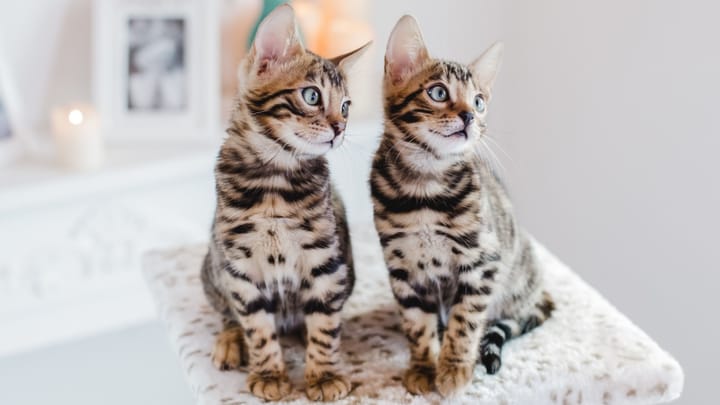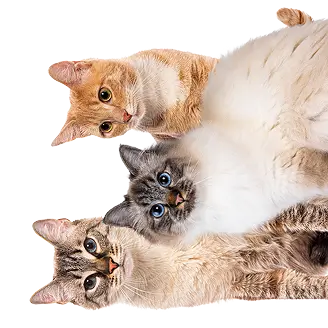Bengal


These cats turn heads with their beauty and boundless energy. They combine grace and elegance and no one can ignore these beautiful cats. They are just like little leopards thanks to their physique and temperament. When you buy a Bengal, you have to be prepared to live with a small tornado! If you like peace and quiet, you probably shouldn’t buy a Bengal, because they will put you through the wringer! On the other hand, if you are prepared to face up to the storm, you’ll have an incredible time with this little leopard and they guarantee hours of play and laughter!
|
Life expectancy |
The Bengal has a life expectancy of between 10 and 16 years |
|
Temperament |
|
|
Adult size |
Female
Approximately 14 in
Male
Approximately 14 in
|
|
Adult weight |
Female
Between 9 and 13 lb
Male
Between 11 and 15 lb
|
|
Coat colour
Brown Tabby, Seal Sepia Tabby, Seal Mink Tabby, Seal Lynx Point, Black Silver Tabby, Seal Silver Sepia Tabby, Seal Silver Mink Tabby, Seal Silver Lynx Point Some Bengals, look like they have a golden powder sprinkled in their hair. This is known as the “glitter” effect. |
Brown |
|
Type of coat
|
Short |
|
Eye colour
|
Green
Blue
Yellow
|
|
Purchase price |
The Bengal costs between £400 and £1500 |
Bengal are hybrid cats, that come from the cross breeding of a wild cat and a domestic cat. There are several generations (from F1 to F5) but F1 to F3 cannot be used in competition. Interestingly, the Indian (Bengali) Leopard (from the eastern part of the Indian subcontinent) was reportedly used for feline leukemia research. It appears that this breed is immune to the disease that is usually fatal in cats. Through the hybridisation process, researchers have been able to track the genetics of their immune systems.
More details about the Bengal
Bengal: Origins and history
Man’s fascination with wild cats has existed for a very long time. In 1963, a woman named Jean S. Mill decided to cross a domestic cat with a wild cat, an Indian (Bengali) leopard. Therefore the breed name was given to pay homage to the feline which made it possible to create the breed. The idea was to get a sweet and friendly cat with the look and physique of a leopard or jaguar. Dr. Mill was entrusted by Davis University in California with 8 hybrid females that had been used for feline leukemia research. Crosses with different breeds have also been made (eg. with Egyptian Mau and Burmese) to avoid incest. The breed as we know it today dates back to the '80s, (more precisely 1985) when Mrs. Mill entered one of her Bengals into a competition. It was obviously a great success and TICA recognized the breed that following year.
Physical characteristics of the Bengal
Bengals are medium to large cats, who are very powerful thanks to their athletic physiques.
Bengal: Characteristics
Bengal: Behaviour
Breed compatibility Bengal
Bengal: Purchase price
On average, Bengal kittens cost between £400 and £1500. Their price varies depending on their lineage, age and even their sex. They cost around £35 / month to look after, in order to keep them in good health, and to feed them with good quality food.
Bengal: Shedding
Average
Bengals only lose a small amount of hair.
Bengal: Grooming
These cats do not require special maintenance. Weekly brushing to remove their dead hair is sufficient.
Bengal: Health
Between 10 and 16 years.
Given the Bengals’ thick fur, their cold-resistance is better than other breeds. Nevertheless, they are short-haired cats with no significant undercoat.
Given that Bengals need more food than other breeds, they can gain weight unnecessarily if their food portions are not well managed. It is important to consult your vet.
- Pyruvate kinase deficiency: This is a deficiency in an enzyme that plays a role in degrading sugars in erythrocytes. PK deficiency leads to death of erythrocytes and anemia in cats
- Hypertrophic cardiomyopathy: it is a condition which causes the heart muscle to thicken. It is actually a syndrome in which we group together several diseases, some of which are well known, some are difficult to diagnose and others are said to be idiopathic (of undetermined cause). This condition is not over-represented in Bengals, but it is still occasionally found.
- The condition can creep up on a cat because they may present no symptoms for many years despite having serious hypertrophic cardiomyopathy. Clinical signs may be difficult to spot (such as loss of appetite and fatigue). In cases where the cat deteriorates quickly, obvious breathing difficulties become apparent. Thromboembolism (clot blocking a blood vessel) resulting in sudden and painful paralysis can also occur.
- Progressive retinal atrophy is a hereditary disease that causes blindness. Sometimes, the disease arises when the cat is old, which mean the cat can adapt to their new “blind” life gradually. For less fortunate cats, the disease can affect them very young and they therefore have very little time to adjust.
They can also suffer from the same diseases as other domestic cats, such as oral diseases.
No cross breeding is authorised.
Do you want a Bengal cat ?
Frequently asked questions
Are Bengal cats good house pets?
Bengal cats are extremely smart and love to learn tricks like playing fetch, high fives, etc. They are also playful creatures and therefore get along well with children who will want to play with them for hours. The Bengal is also very athletic, active, and affectionate when it's time to rest. If introduced early, the Bengal gets on well with other cats and dogs. This beautiful cat breed is a good house pet as long as you keep him entertained, active and healthy.
Are Bengal cats expensive?
The Bengal cat is one of the most expensive cat breeds. On average, they cost between £400 and £1500. Their price varies depending on their lineage, age and even their sex. To look after this breed, it costs around £35 / month (nutrition and medical needs).
Do Bengal cats like to cuddle?
The Bengal cat isn't the most affectionate cat breed and would rather go outside to play rather than lying down on its owner's laps. But when it's time to rest, the Bengal gets very cuddly.
How long does a Bengal cat live for?
The life expenctancy of a Bengal cat is between 10 to 16 years.
Are Bengal cats good with dogs?
If introduced early and the dog is cat-friendly, then yes Bengal cats are good with dogs. It is often said that Bengal cats have a dog personality: they love to play, learn tricks and need a lot of exercise, therefore they'll be great companion for your dog.
1 comment
-
1 comment out of 1
Are you sure you want to delete the comment?








